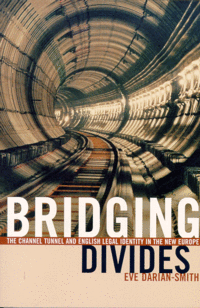

![]()
![]()

Darian-Smith goes on to develop her argument through a fascinating account of the intersections of law and landscape in English identity making: for me, the most effective parts of the book. She makes a claim to trace the 'aesthetics of law' in England, in particular the ways in which the juridico-political idea of the nation-state has been historically connected to territory. Darian-Smith points out that the very doctrine of legal precedent, which underpins representations of English law, relies on an image of 'olde England', which in turn relies on a heavily mythologized sense of a rural English landscape (embodied in the notion of Kent as the 'garden of England'), and a natural island independence. The building of The Channel Tunnel is in this sense a challenge to the notion of the 'naturalness' of English law and the permanence of landscaped boundaries. Darian-Smith suggests that the Tunnel has the symbolic power to disconnect law and landscape in the English imagination, to pull apart and thus reveal the country's lack of spatial continuity and legal sovereignty. As a consequence, alternative legal landscapes may be articulated.
I would perhaps have liked a more thorough investigation of these intersections between law, landscape and identity. In particular, I felt the book suffered from a lack of ethnographic precision. If these legal landscapes are lived topographies, then whose England do they animate? Darian-Smith does not really provide us with enough information about the subjects she describes or the ways in which their very specific sense of place informs their everyday lives. What are the qualities of this landscape and how do people dwell or pass through it? Also, I would have liked to see a more thorough investigation of competing local landscapes and senses of place. If we are to take the intersection between law and landscape seriously (which I would like to do), then we need to know a lot more about how that relationship is articulated. How is 'place' animated by the imagination taken from law? How is 'law' animated by the imagination taken from place? And what is 'law' to the people in Kent she worked with? These questions, I believe, are important, especially when the author makes a claim to providing ethnography. However, I would not like these points to cloud my general enthusiasm for the book, which I think is a fine and timely piece of scholarship.
Adam Reed
University of Surrey